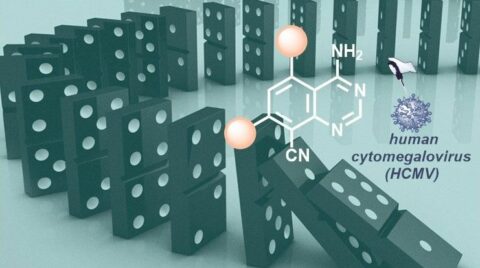Domino effect in pharmaceutical synthesis
FAU researchers forge new strategies in generation of active pharmaceutical ingredients
Chemists at Friedrich-Alexander University Erlangen-Nürnberg (FAU) headed by Prof. Dr. Svetlana B. Tsogoeva at the Chair of Organic Chemistry I have made research into pharmaceutical ingredient synthesis more efficient, more sustainable and more environmentally friendly. They have developed a novel synthetic route towards antiviral quinazoline heterocycles that have not been described previously in professional literature. The results of their work have recently been published in the renowned journal Nature Communications.
Heterocycles, ring shaped molecules which contain at least one heteroatom (such as nitrogen, oxygen, sulphur) play a central role in drug development research. They are contained in the vast majority of all pharmaceutics on the market. Quinazoline is a heterocycle and is, for example, a subunit of many anti-cancer drugs. Up to now, the synthesis of quinazoline heterocycles was very costly and required many individual steps starting with expensive compounds and reagents. In addition, fluorescence markers had to be linked to a drug to make its uptake into a cell visible.
The chemists at FAU have now developed a highly efficient method using metal-free domino processes. This simplifies the synthesis of the pharmaceutical ingredient and makes it more sustainable and economical. In so-called domino reactions, all of the required simple initial compounds and a solvent are mixed in one flask, in which multiple reaction steps take place without the addition of further reagents. Within a domino reaction one transformation triggers the next, similar to a row of dominoes where one tile hits the next. This synthesis makes isolation and purification of the intermediate products superfluous.
The FAU chemists have now combined three such metal-free multi-step domino reactions for the first time, and have run them in the same reaction flask. Lab work time, costs, waste, and the environmental footprint can be reduced using this combination in a ‘one-pot’ synthesis. This novel one-pot domino process creates a completely new type of quinazolines, which have intrinsic fluorescence properties. This means an extra fluorescence marker to make the substance visible is no longer necessary.
In addition, the novel quinazolines have shown that they are highly effective against herpes viruses, and in contrast to many other bioactive compounds, do not damage healthy cells. This reduces possible side effects and increases the therapeutic range.
The research results of the project funded by the German Research Foundation (DFG) were published under the title ‘Facile access to potent antiviral quinazoline heterocycles with fluorescence properties via merging metal-free domino reactions’: Nat. Commun. 8/15071; doi: 10.1038/ncomms15071 (2017).
Further information:
Prof. Dr. Svetlana B. Tsogoeva
Phone: +49 9131 85-22541
svetlana.Tsogoeva@fau.de
